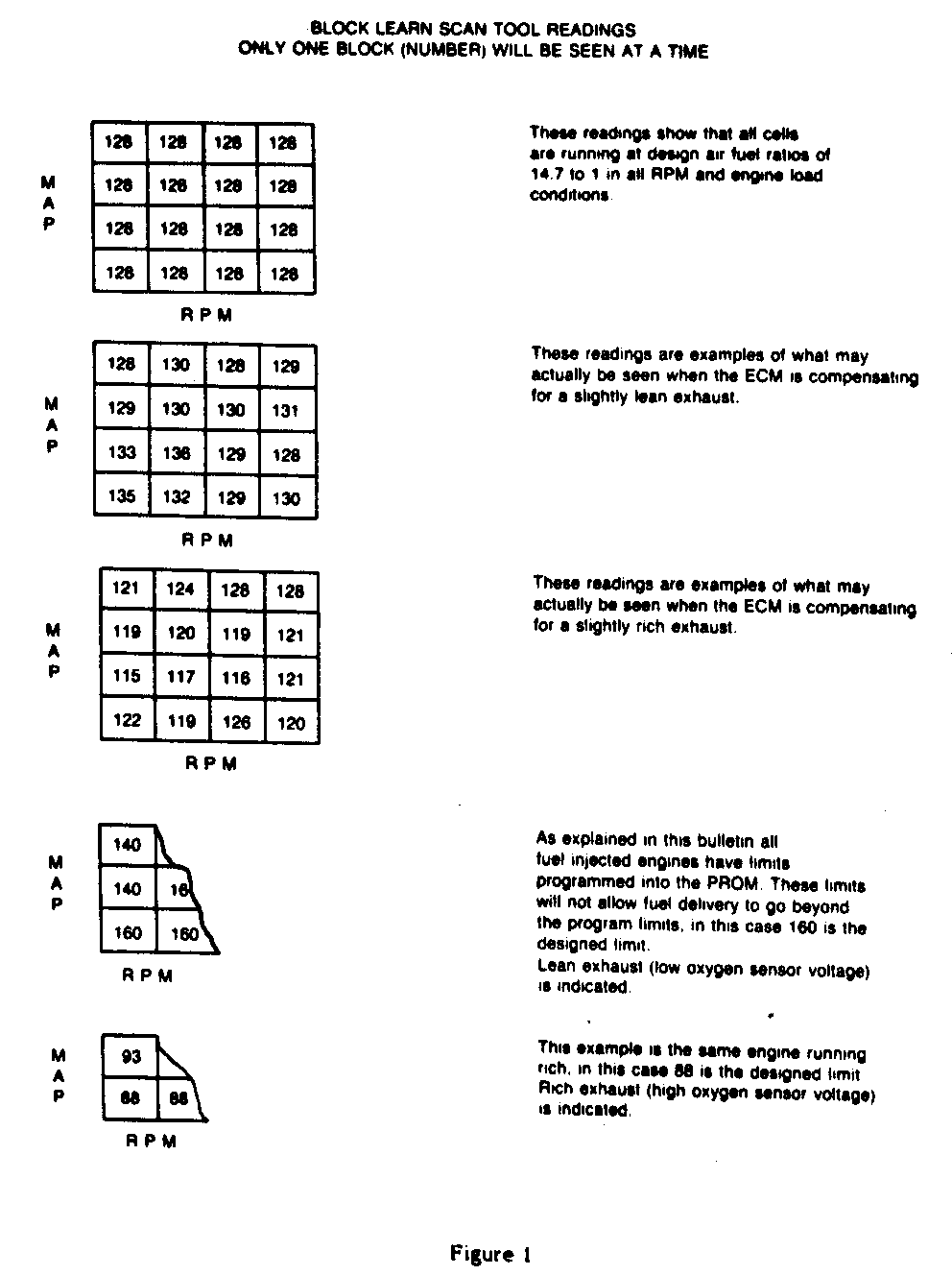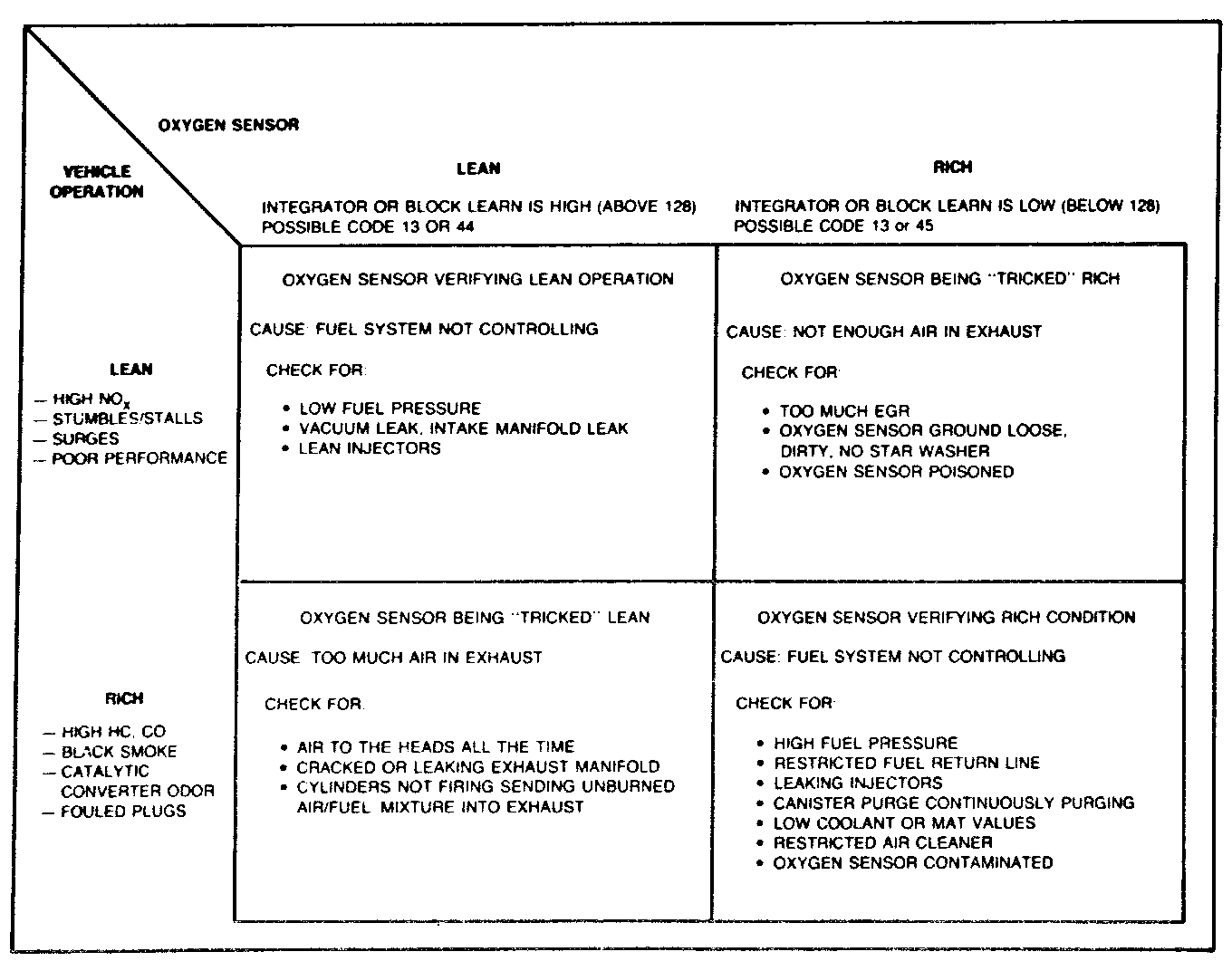FUEL CONTROL DIAGNOSIS INFORMATION

MODELS AFFECTED: 1986 DEVILLE, FLEETWOOD, ELDORADO, SEVILLE, CIMARRON, AND BROUGHAMS
All 1986 DFI-equipped vehicies have two new ECM data parameters useful for fuel system and driveability diagnosis.
Integrator - parameter P.1.4 on "C" cars and EDL9 on "E/K "cars
Cross counts - parameter P.1.3 on "C" cars and ED18 on "E,'K" cars
These parameters display information about oxygen sensor activity and ECM fuel control as explained in this bulletin.
On vehicles equipped with the 2.0L EFI or 2.8L PFI engines, an additional parameter, called "Block Learn"or "Block Learn Multiplier" can be displayed using a scan tool. The chart on the last page (Figure 2) explains how to use these parameters when diagnosing vehicles with fuel system and driveability complaints.
INTEGRATOR
The fuel control integrator parameter indicates how the ECM is controlling fuel delivery.
The integrator may be set to a value of 128 when an acceleration enrichment, power enrichment, deceleration enleanment, power steering anticipate, A/C anticipate or P/N to D/R anticipate is issued from the ECM. From 128, the integrator will move higher (add fuel) if the ECM sees a lean signal from the oxygen sensor or the integrator will move lower (subtract fuel) if the ECM sees a rich signal from the oxygen sensor.
Integrator movement is based on the averaging, or integration, of oxygen sensor voltage. If the ECM sees a rich indication for a longer time than a lean indication, the ECM will subtract fuel to achieve a 14.7:1 air/fuel ratio. Conversely, if the ECM sees a lean indication for a longer period of time than a rich indication, the ECM will add fuel to compensate., Integrator values will range from approximately 88 counts to 160 counts.
CROSS COUNTS
Cross counts, or oxygen sensor cross counts, is an indication of how many times the oxygen sensor has toggled rich/lean in a one second period.
At idle, a value of 0 is not unusual since there is a low flow of exhaust gas across the oxygen sensor. As engine RPM increases, cross counts should increase as a result of increased exhaust gas flow across the oxygen sensor. At part throttle in P/N, cross counts should be greater than 10. Exceptions to this is when a power enrichment, acceleration enrichment or other anticipate (Power Steering, A/C, gear change) occurs causing the integrator to reset to 128.
The value displayed when selecting the cross counts parameter may be larger than the number of times the rich/lean status light toggles within one second. The reason for this is because the rich/lean status light is not updated as often as the cross count parameter. Since the cross count parameter is updated quickly, it is the best indicator of oxygen sensor activity.
BLOCK LEARN
Block learn is a portion of ECM memory used to adjust fuel delivery across all operating conditions of the engine. The ECM reserves memory locations for various load conditions of the engine specified by MAP and RPM (see Figure 1). Each location represents a "block", or specific operating condition of the engine. Within a block the ECM stores a number that represents fuel adjustment (similar to the integrator).
A value of 128 in a given block indicates no fuel adjustment is needed for that engine load condition. A higher number indicates that the ECM has seen lean operation under those conditions and is adding fuel to compensate. Conversely, a lower number indicates that the ECM has seen rich operation under those load conditions and is subtracting fuel to compensate. On DFI equipped vehicles, all block learn values are reset to 128 when long term memory power is removed from the ECM as indicated by a Code E52.
The ECM learns, or adjusts fuel, under most load conditions to achieve 14.7:1 air/fuel ratio once the engine has warmed up. Block learn values compensate for lean or rich operation based on integrator values for given engine load conditions. For example, if the integrator value is consistently above 128 for a given load condition, the block learn value will adjust upward to compensate for the lean air/fuel mixture condition. Block learn values are long term fuel compensation values stored in ECM memory. Short term, or transient, fuel control is accomplished using the integrator.
ENGINE PERFORMANCE DIAGNOSIS (Refer to Figure 2)
When diagnosing engine performance and particularly fuel control problems, an accurate understanding of the relationship between oxygen sensor, fuel integrator, block learn, and engine emissions is essential. The following discussion will explain the retationship between these elements. This is to aid in diagnosing fuel control problems when using an engine performance analyzer and on-board diagnostic parameters.
There are four fuel control operating conditions that can be diagnosed using oxygen sensor and engine emissions information. In each case, the information available about the oxygen sensor (cross counts, integrator, and block learn) will help pinpoint the cause of poor vehicle performance.
NOTICE: High or low integrator or block learn values do not necessarily indicate a faulty system. Only use this diagnosis if the vehicle is exhibiting the "symptoms" listed below.
#1 - Lean engine operation with oxygen sensor indicating lean operation.
Symptoms: Stumbles/stalls, surges, poor performance, excessive NOX, low indicated fuel economy on FDP or DIC.
Parameters: 02 voltage reinains low (below .45 v), very high integrator and/or block learn values (above 128).
Possible - Low fuel pressure Causes. - Vacuum leak, intake manifold leak - Lean or wrong injectors - No EGR operation
#2 - Lean engine operation with oxygen sensor indicating rich operation.
Symptoms: Stumbles/stalls, surges poor performance, excessive NOX, low fuel economy.
Parameters: O2 voltage remains high (above .45v), low integrator and/or block learn values (below 128).
Possible 02 signal is being "tricked" rich, check for: Causes: - Too much EGR - 02 ensor ground loose, dirty, star washer missing - Contaminated 02 sensor (oil or carbon fouled).
#3- Rich engine operation with oxygen sensor indicating lean operation. (Oxygen sensor is being "tricked" lean)
Symptoms: Black smoke, catalytic converter odor, fouled plugs, high CO and HC.
Parameters: 02 voltage remains low (below .45v), high integrator and/or block learn values (above 128).
Possible - Contaminated 02 sensor (silicon fouled). Causes: - AIR being directed to the heads all the time - Cracked or leaking exhaust manifold - Cylinder not firing, sending unburned air through exhaust (ignition related misfire)
#4 - Rich engine operation with oxygen serksor indicating rich operation.
Symptoms: Black smoke, catalytic converter odor, fouled plugs, high CO and HC.
Parameters: 02 voltage remains high (above .45v), low integrator and/or block learn values (below 128).
Possible - High fuel pressure (blocked fuel return line, inoperative fuel Causes: pressure regulator) - Leaking or wrong injectors - Canister purge purging all the time - Low coolant or MAT values - Restricted air cleaner


General Motors bulletins are intended for use by professional technicians, not a "do-it-yourselfer". They are written to inform those technicians of conditions that may occur on some vehicles, or to provide information that could assist in the proper service of a vehicle. Properly trained technicians have the equipment, tools, safety instructions and know-how to do a job properly and safely. If a condition is described, do not assume that the bulletin applies to your vehicle, or that your vehicle will have that condition. See a General Motors dealer servicing your brand of General Motors vehicle for information on whether your vehicle may benefit from the information.
